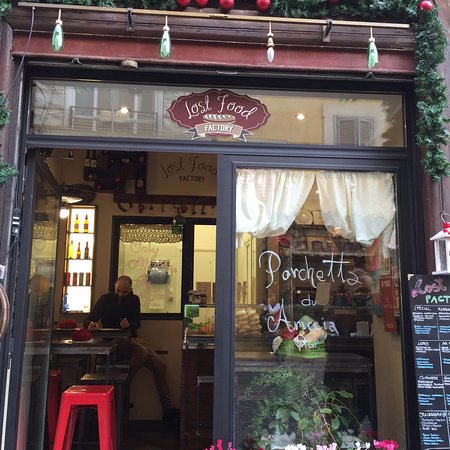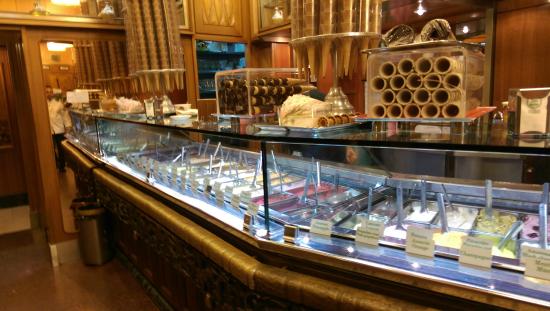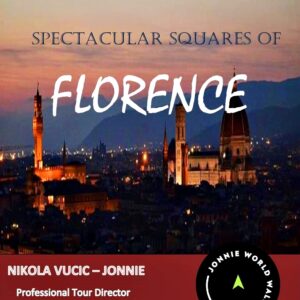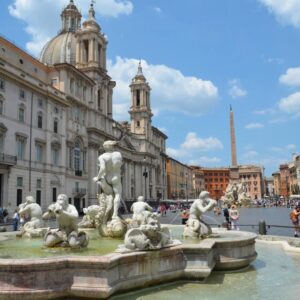Face to face with Pantheon in Rome
With its spectacular architecture, religious importance, elegance and monumentality, Pantheon in Rome represents unique temple icon and eternal symbol of human creativity inspired by divine.
Strolling through fascinating maze of narrow streets in Rome. Locals and street vendors are around, smell of local dishes impale every corner, while facades with rooftop gardens make a signature patchwork of the “eternal city”. After the magical Trevi Fountain, glorious and noble Navona Square and many other jewels of Rome, you think how nothing can surpass your amazement with this city. Until you suddenly step on a square packed with ancient architectural marvels. Being face to face with gigantic structure of Pantheon in Rome is a matter of privilege, so use your chance to explore the most well preserved ancient temple you’ve ever seen. It dominantly occupies the space of a small square, adorned with a charming fountain and surrounded by pastel – color facades of the old palaces. Importance and glory of the Pantheon were secured with its initial purpose – to serve as a temple of major gods of Roman paganism. We are dealing with the purest master piece of classical architecture with its incredible story, which started in 27 BC.

After 2000 years, Pantheon still stands firm
panthEon’S story IN ANCIENT ROME
The whole plan grew in a genius mind of Marcus Agrippa – architect and wise politician, who’s aqueducts and temples changed the face of Rome forever. He deserves so much the inscription placed just under temple’s pediment: MAGRIPA LF COS TERTIUM FECIT (Marcus Agrippa, son of Lucius, the third time consul did this). Above it, blank triangular space can be noticed, with plenty of holes on it. This is where beautiful bas relief blocks were attached to represent gods Jupiter, Junona and Minerva. Ancient Romans were proud of the house of their mighty Gods. Roof structure used to shine, covered with perfectly polished bronze plates, surviving even Barbaric invasions. During XVII century, greedy and ambitious Pope Urban VIII took off all the bronze and used it for casting giant canopy above the main altar of St. Peter’s Basilica.

Pantheon facade inscription in Latin

Pantheon portico columns
From that moment on, Barberini family of the Pope Urban VIII, will be marked forever by the sentence created by Roman people : “What Barbarians haven’t done, Barberini did”. Roof and row of supporting columns, last time reinforced by Emperor Hadrian around 138 AD, form monumental entrance to the temple with a round shaped plan (so called rotonda). You can admire mighty walls, 20ft (6m) thick with incorporated brick arches in them, thus enabling perfect distribution of dome weight to the reinforced arch points.
PANTHEON’S MIGHTY DOME
Finally, supporting walls are reaching the marvel of the Pantheon – its dome. What kind of engineering miracle Romans used to build a dome in the first century BC, that is 3ft bigger in diameter, than St. Peter’s Basilica dome, finished more than 1600 years later!? Using arch form in architecture, implementing concrete and bricks, is just the beginning. In the section where wall of the Pantheon touches dome, is where the thickest part of the dome starts. How it continues to its top, dome becomes thinner and thinner. To make gigantic dome lighter, Romans did not use blocks or bricks for thick parts. Instead, they incorporated perfectly light, pumice volcanic stone and hollow objects like vases or amphoras. Brilliant solution is crowned by the top opening hole, 30ft in diameter. This is the “eye” or oculus of the temple, designed to light the interior and to enable air flow.
Night charm of the Pantheon
“No doubt we are dealing with master piece of classical architecture…”
Obvious fascination by the Pantheon in Rome, brought us an old story, how specific construction of the oculus disables rain drops to fall into the temple. This might be true, eventually when dealing with light rain and specific air flow through the oculus. In case of heavy rain, enter Pantheon and test this claim for yourself by observing both rain drops and small drainage holes on the temple’s floor. Pantheon’s interior is a live witness of how the cradle of Paganism finally becomes a Christian church. You can easily imagine statues of major Roman gods, standing in the niches, richly decorated with precious stones, gold and silver jewelry. Today, polychrome marble chapels and regular masses in a Pantheon/Church dedicated to Virgin Mary and Christian Martyrs is something special to experience. Instead bowing in front of statues of Jupiter, Venus or Apollo, we are paying a tribute to illustrious people buried inside the Pantheon. Those who were immortalized and honored here, shaped Europe, Italy and Rome in a unique and profound way.
Pantheon’s dome and the “oculus”


Bust of Marcus Agrippa
rOMAN PANTHEON Interior treasures
To the right from the entrance, monumental coffin can be seen. Dignity is there, while inscription PADRE DE LA PATRIA, tells enough about father of the nation – Victor Emanuel II, first King of Italy. Prominent member of the noble Savoy Dynasty, he was a person who opened new chapter by unifying Italy and tracing a path to Italian modern era. Across him, on the opposite side of the Pantheon, lies Umberto I, second king of Italy, with his wife, Queen Margherita, thus glorifying most influential royal family members. In addition, almost hidden beneath a statue of Virgin Mary with baby Christ, lies an ancient sarcophagus. Latin verses on it, speak for themselves: “While he was alive, mother of all things (nature) was afraid to be surpassed. When he died, she was afraid to die too”.

Impressive interior of the Pantheon
These fabulously touching words can portrait only one genius – painter Raphael. His tomb inside the eternal temple is a signature of an unsurpassed talent, kept for the generations to come. Looking up, towards the interior of the dome, I am seeing a bright sunray coming from the oculus, enlightening Pantheon in Rome, this sacred, Pagano – Christian space.

Raphael’s tomb. Pantheon, Rome
Despite millenniums behind, Pantheon still fascinates. Questions to be answered still exist, about the place where marvels of architecture play together with spirit of ancient gods, Christian martyrs, and brilliant minds of Italy.
Endless inspiration called Pantheon is waiting to be revealed and understood…

Charming night around Pantheon
Travel Authentic. Live Inspired.
Ready to explore more?
♣
Sneak inside the Pantheon and reveal secrets of its marvelous dome with Naked Science expert video.
video and picture by Naked Science YouTube Channel
♣
After being deeply affected by treasures of Pantheon, you might wish to regain your energy with some super typical Roman bites. Check out Jonnie World Walker recommendation for two affordable places, so close to the Pantheon and so tempting with their food options.
Lost Food Factory, Via della Maddalena 50, 00186 Rome, Italy
Just a minute walk from the Pantheon, you can find small, but rustic and charming place to offer amazing variety of local panini (sandwiches), fresh juices, salads and more. Taste what kind owners will offer or create your own panino combining types of prosciutto, pecorino Romano cheese, grilled vegetables in olive oil, perfect sun dried tomatoes, or just grab crispy porchetta sandwich and a beer. Very affordable prices for such a centrally located place and superb quality of service.

foto by tripadvisor.com
Gelateria Giolitti, Via Uffici del Vicario, 40, 00186 Rome
Legendary, traditional and always tempting, Giolitti is simply an Italian gelato and pastry temple dating from 1900. Just interior is a blend of colors, smells and flavors of supreme sweet delicacies of Italy. Do not let yourself to be discouraged by the line up of curious faces waiting for their piece of gelato eternity. Just admire the atmosphere and choose small, medium (advisable for 3.80 EUR only), large (too big) or XXL gelato (like an ice cream olympic torch) and enjoy flavors of a lifetime.

foto by tripadvisor.com















